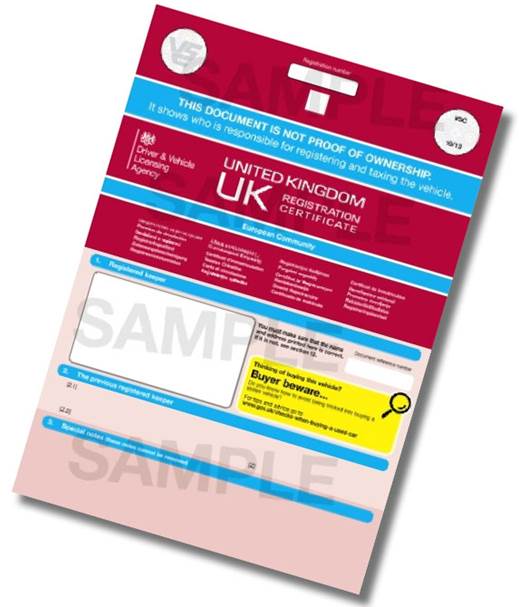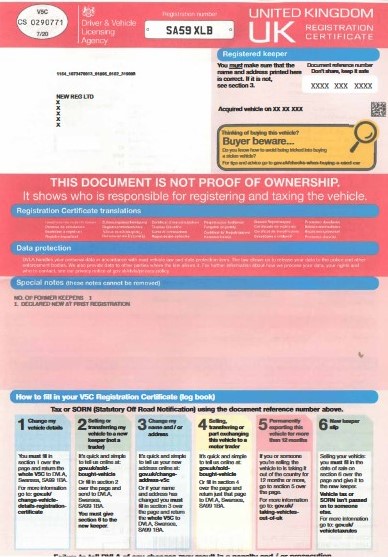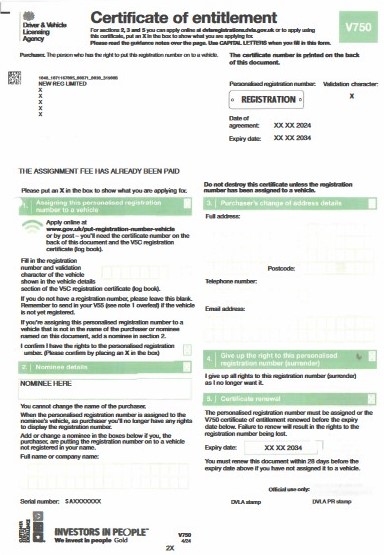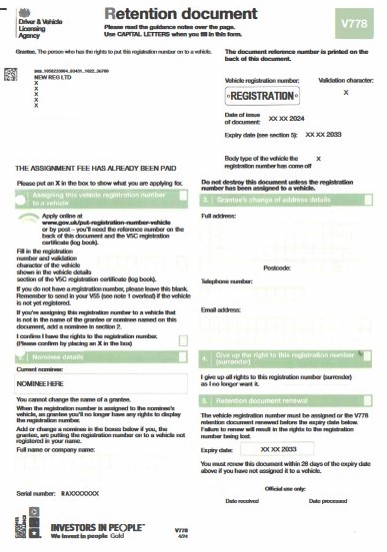I’m Steven Jackson and over the last 35 years in this industry and as a recognised DVLA reseller I’ve seen many changes. The biggest one being the invention of the internet which meant we could invite our customers to private plates purchase online! There have been the new registration number formats, whole process changes and of course with that follows changes to paperwork, including the process of buying and selling DVLA number plates.
Here I look at the three documents one of which you will have if you have your own personalised number plate and that you may need if you have private number plates to sell or wish buy a private number.
Types of Vehicle Documents
When buying or selling a private number plate, understanding the various vehicle documents involved is crucial. Here are some of the most common documents you’ll encounter:
- V5C: Often referred to as the logbook, the V5C is the vehicle registration document. It contains essential information about the vehicle, such as its make, model, and registration number. This document is vital for proving the vehicle’s registered keeper.
- V750: This certificate of entitlement is issued by the DVLA when you purchase a private number plate. It confirms your right to the registration mark and is necessary to complete the transfer process.
- V778: Known as the retention document, the V778 is issued by the DVLA when you decide to retain a private number plate. It confirms your right to the registration number and allows you to transfer it to another vehicle in the future.
V5C UK Registration Certificate (DVLA Registered Vehicles)
The V5C contains the name and address of the registered keeper and vehicle details (commonly called the Log Book). It shows the keeper NOT the legal owner, if you need to prove ownership of the vehicle you need a receipt or invoice from when you purchased it.
Going back to changes, well there have been many over the years. Older car or motorbike owners may never have applied for a modern V5C if the vehicle is sat in a shed as a restoration project!
In 2006 DVLA had to phase out the blue version introduced in 2004 and replace it with a new version after a batch of blank documents had been stolen. They were similar in style just mainly red rather than blue.

This version has since been replaced by the current style V5C which DVLA introduced in April 2019. Although previous versions are still valid, any changes that trigger a new V5C will result in a new style V5C being sent. If therefore you submit an address change or change your private number plates then expect DVLA to send you the new version as a replacement.

Registered keepers are asked to ensure that their personal registration details are correct and that the easily identifiable characteristics such as Make, Model, Colour, VIN/Chassis and Engine Numbers on their V5C are correct. If there are any inaccuracies, the V5C must be returned to the DVLA for an amendment.
Private Number Plates
If you purchase a private plate you will need to submit your V5C to DVLA as part of the application to transfer the number to your vehicle. If you buy a private number from New Reg we offer a service where we handle this for you. We are dedicated to helping you find the perfect personalised number plate.
If you are familiar with private number plates you’ll know that you don’t have to display your private plates on a vehicle. Your personalised number plate can be held on a certificate and there are two versions.
Private registration plates issued by DVLA Personalised Registrations are effectively brand new private number plates that have never been assigned to a vehicle before and are issued on a V750 Certificate of Entitlement. A private registration mark that has been taken off a vehicle will be issued on a V778 Retention Document.
V750 Certificate of Entitlement
The V750 hasn’t changed much since I started trading in private number plates. Initially they were only valid for a year and would need renewing a year at a time. Later the option to renew for one, two or three years was introduced and eventually the entitlement period was increased to 10 years, regardless the appearance remained much the same; a mostly pink document. However in January this year (2024) the DVLA introduced a new version that is barely recognisable, as you can see, no pink at all! The biggest change is that for security the certificate reference number is now on the rear of the document.


V778 Retention Document
Much like the V750, the V778 hadn’t changed much until January 2024. The new V778 is virtually identical to the new V750. Originally a V778 was issued for a period of one year when an owner took the number off their vehicle (retained it). This period could be renewed for a further year but since 2015 new documents are issued for a period of 10 years and must be assigned to a vehicle prior to the expiry date or that period extended.


Another big change is that the new V750 and V778s don’t require a signature whereas the old versions required sections 1 and 6 to be signed by owners when they were changing their address for example or assigning their private number plates to vehicles.
Buying a Private Number Plate
Purchasing a private number plate can be an exciting venture, but it’s essential to do your homework and choose a reputable supplier. Here are some tips to help you find the perfect plate:
- Use a Reputable Supplier: Ensure the supplier is registered with the DVLA and like New Reg has a solid reputation in the industry. This guarantees a secure payment process and reliable service.
- Check the Plate’s History: Use the DVLA’s online service to check the plate’s history. This step ensures the plate hasn’t been previously used on a vehicle that’s been written off or has outstanding finance.
- Consider the Plate’s Age: If you want a plate that matches your vehicle’s age, make sure to choose one that’s appropriate. This adds a touch of authenticity to your vehicle.
- Check the Plate’s Format: Private number plates come in various formats, including dateless, prefix, and suffix. Select a format that suits your vehicle and personal preference.
Selling a Private Number Plate
Selling a private number plate can be a profitable endeavor, but it’s important to approach it wisely. Here are some tips to help you sell your plate effectively:
- Use a Reputable Supplier: Look for a supplier registered with the DVLA and well-regarded in the industry. This ensures a smooth and secure transaction.
- Get a Valuation: Obtain a valuation from a reputable supplier to understand your plate’s worth. This helps you set a competitive price and attract potential buyers.
- Advertise Your Plate: Use online marketplaces and specialist websites such as Newreg.co.uk to advertise your plate.
Personalised Number Plate Options
Personalised number plates are a fantastic way to add a unique touch to your vehicle. Here are some options to consider:
- Dateless Plates: These plates don’t have a specific date or age associated with them, making them suitable for vehicles of any age. They offer a timeless appeal.
- Prefix Plates: Featuring a prefix letter or number that indicates the vehicle’s age, these plates are a popular choice for those who want to reflect their vehicle’s era.
- Suffix Plates: Similar to prefix plates, suffix plates have a suffix letter or number that denotes the vehicle’s age. They are another great option for age-specific personalisation.
- 4D Plates: These plates have a 4D effect, giving the appearance of raised letters and numbers. They add a modern and stylish look to your vehicle.
- Coloured Borders: Adding a coloured border to your plate can give it a distinctive and personalised look, making your vehicle stand out even more.
You should now be ready to navigate the world of private number plates with confidence and ease. Whether buying, selling, or personalising, understanding the process and documents involved ensures a smooth and enjoyable experience.